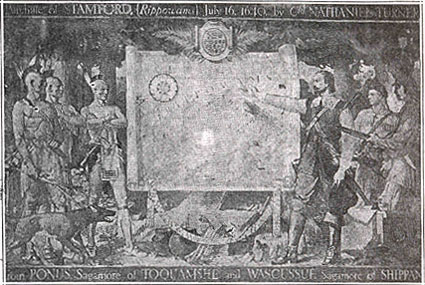Old Town Hall II – Indian Mural
Saturday, July 28, 1934
Mural Depicts Purchase of Stamford

The mural hung this week in the office of Town Clerk George R. Close, depicting
the purchase of what is now Stamford from the Indians, has been attracting
considerable attention. It was painted by Arthur Gibson Hull, and is
one of the Public Works of art projects made possible through the Federal
Government and the town.
Part of It.
The painting was first done on canvas at the home of the artist in Norwalk,
but has been so placed on the wall as to seem a part of it. It is 12 feet
long and eight feet high. It shows Indian chiefs at the left facing white
men on the right across a large map of the territory purchased, surmounted
by the old coat of arms or seal of the Connecticut colony, bearing 15 grape
vines on its field instead of three as at present.
Below are grouped the knives, hatchets, hoes, kettles, coats and wampum
which formed the purchase price. A forest background of pines and hard
woods, together with a balanced and even distribution of design, and rich,
but subdued colors, tend to give this mural something of an antique tapestry
effect that adds much to its charm.
Largely Responsible.
Mr. Hull said that Clark Weed, whose interest in things Colonial and the
early history of Stamford is well known, is largely responsible for the
preliminary research necessary in a work of this character, and spared
no effort to make the painting a thing of I value to the town.
Mr. Hull added that while a great deal of care was taken to make the details
of costumes and
implements authentic for the period, no portraits of those who took part
in the original purchase of Stamford are available, as far as could be
determined, nor indeed anything more than a bare record of the transaction.
So this painting is not so much a picture of an actual scene as an imaginative
decoration symbolizing an important event.
The land now comprising the
town of Stamford, quaintly called a "plantation" at
that time, was bought under the Indian name of Rippowam for the New Haven
Society In the Summer of 1640 by Capt. Nathaniel Turner and sold In the
Fall of the same year to a group from Wethersfield who started a settlement
the following year. The names "Ponus," "Rippowam," "Toquams" and "Shippan" which
occur in the old deeds are still identified with the life of the town and
its environs.
back to Old Town Hall II

